Wow, this is my 500th blog post and it has been great fun to share my images and the stories behind them. I thought I’d share a few images and bits about my thoughts on photography.
 Adult Dunlin feeding – Nikon D200, handheld, f7.1, ISO 200, 1/250, Nikkor 80-400mm VR at 400mm, natural light
Adult Dunlin feeding – Nikon D200, handheld, f7.1, ISO 200, 1/250, Nikkor 80-400mm VR at 400mm, natural light
What got me hooked on bird photography?
I would say shorebirds are why I am addicted to bird photography because they fascinated me and photographing them allowed me to crawl through mud, sand and water.
When I first started photographing shorebirds I could walk around covered in mud with my camera in my hand people just ignored me or would say “Wow, that camera must take good pictures”. Maybe they were too polite to mention that I had sand all over my face, muddy legs or a combination thereof.
 Sanderling in nonbreeding plumage – Nikon D200, handheld, f6.3, 1/1000, ISO 200, Nikkor 80-400mm VR at 400mm, natural light
Sanderling in nonbreeding plumage – Nikon D200, handheld, f6.3, 1/1000, ISO 200, Nikkor 80-400mm VR at 400mm, natural light
I simply loved being out in nature, the feel of the sea breeze on my skin, having warm water lapping against my legs and the birds that I saw everywhere around me. I learned that if I sat or laid very still the birds would approach me and allow close ups like the Sanderling image above. Even when there were no birds around I could wade into the water fully clothed and just make it “look” like I was searching for birds while cooling off and giggling because I was in the water with all my clothes on and I didn’t care one bit.
While slithering around in mud and sand crawling through sugar sand I had many wonderful opportunities to meet and make friends with a lot of like-minded people who love nature. I figured if they crawled around in the mud with me and didn’t mind that I smelled like a combination of fish and crab poop they had to be great people.
I learned a lot about shorebird ID, which were peeps, plovers and sandpipers and then figured out the rest. Breeding and nonbreeding plumage puzzled me for a bit but with experience, people who let me pick their brains and field guides I’ve become proficient at figuring out shorebird ID.
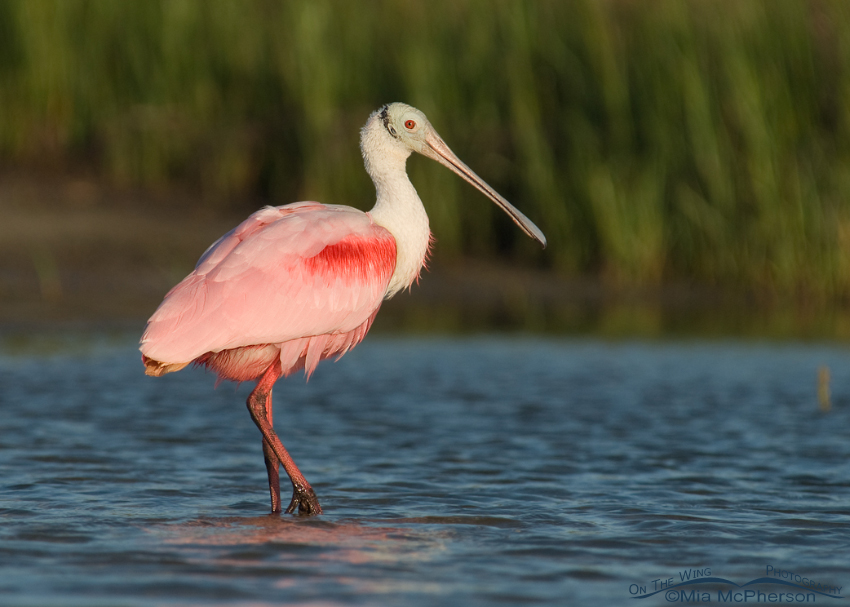 Roseate Spoonbill in morning light – Nikon D200, handheld, f6.3, 1/750, ISO 250, Nikkor 80-400mm VR at 400mm, natural light
Roseate Spoonbill in morning light – Nikon D200, handheld, f6.3, 1/750, ISO 250, Nikkor 80-400mm VR at 400mm, natural light
Then there were the larger wading birds, some with razor-sharp bills, some that curved downwards, looked like wood and spoons! I got addicted to photographing them too.
I learned not to over saturate the colors of my subjects in post processing so that they looked like what I saw through my viewfinder. The Roseate Spoonbill above is colorful enough without pushing that saturation slider up.
Why do I always mention “natural light” in my techs under the images I post?
My answer to that is that nature provides terrific light and I don’t like using flash on birds or other wildlife. I just prefer natural light over artificial.
 Dancing white morph Reddish Egret – Nikon D200, handheld, f6.3, 1/1250, ISO 250, Nikkor 70-300mm VR at 250mm, natural light
Dancing white morph Reddish Egret – Nikon D200, handheld, f6.3, 1/1250, ISO 250, Nikkor 70-300mm VR at 250mm, natural light
I studied the behavior of my subjects so I could tell when they were about to take flight, bathe, catch prey or dance like the white morph Reddish Egret above. The egret isn’t truly dancing, it is actively chasing after prey.
By observing my subjects I have gotten great action images that I might have missed if I hadn’t been able to anticipate their next move.
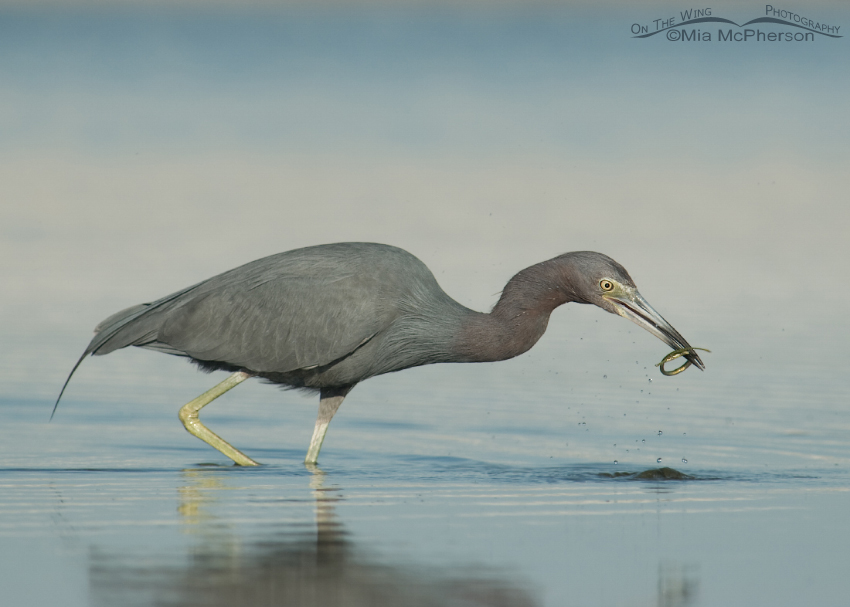 Little Blue Heron with a Bay Pipefish – Nikon D200, handheld, f6.3, 1/800, ISO 160, Nikkor 80-400mm VR at 400mm, natural light
Little Blue Heron with a Bay Pipefish – Nikon D200, handheld, f6.3, 1/800, ISO 160, Nikkor 80-400mm VR at 400mm, natural light
I found out that going out to photograph with other people was very enjoyable and that knowledge about techniques could flow easily back and forth. I photographed the Little Blue Heron with a Bay Pipefish above with two photographer friends and we all walked away with images that we were very happy with.
I worked on my stalking skills and patience so I could get closer to my subjects without stressing them or making them flush. Of course; some still flush & fly.
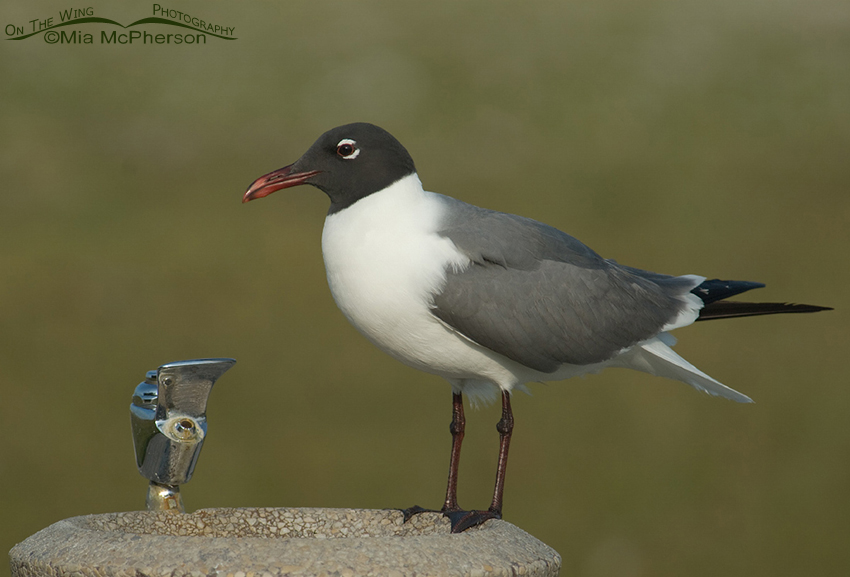 Laughing Gull in breeding plumage at a water fountain – Nikon D200, handheld, f6.3, 1/1000, ISO 250, Nikkor 80-400mm VR at 400mm, natural light
Laughing Gull in breeding plumage at a water fountain – Nikon D200, handheld, f6.3, 1/1000, ISO 250, Nikkor 80-400mm VR at 400mm, natural light
I feel that all birds are worthy subjects and that even the most common birds can be uncommonly beautiful in the right light, pose or setting. Normally I prefer natural settings and perches but I also enjoy images that have manmade items in them. I think the water fountain as a perch for this Laughing Gull adds a touch of whimsy.
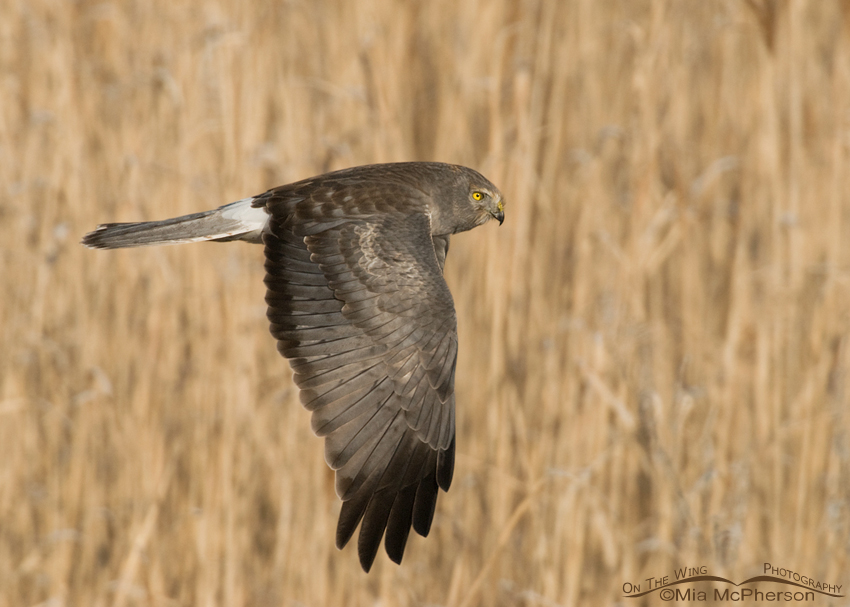 Male Northern Harrier in flight – Nikon D200, f7.1, 1/2000, ISO 320, +0.3 EV, Nikkor 200-400mm VR with 1.4x TC at 400mm, natural light, not baited
Male Northern Harrier in flight – Nikon D200, f7.1, 1/2000, ISO 320, +0.3 EV, Nikkor 200-400mm VR with 1.4x TC at 400mm, natural light, not baited
Paying attention to how close the background material is to the subject is important. If the dried Phragmites behind this male Northern Harrier had been any closer to the bird the background may have looked very messy but because of the distance from the harrier to the vegetation plus my choice of aperture and the bokeh of the lens created a background that doesn’t draw attention away from the subject.
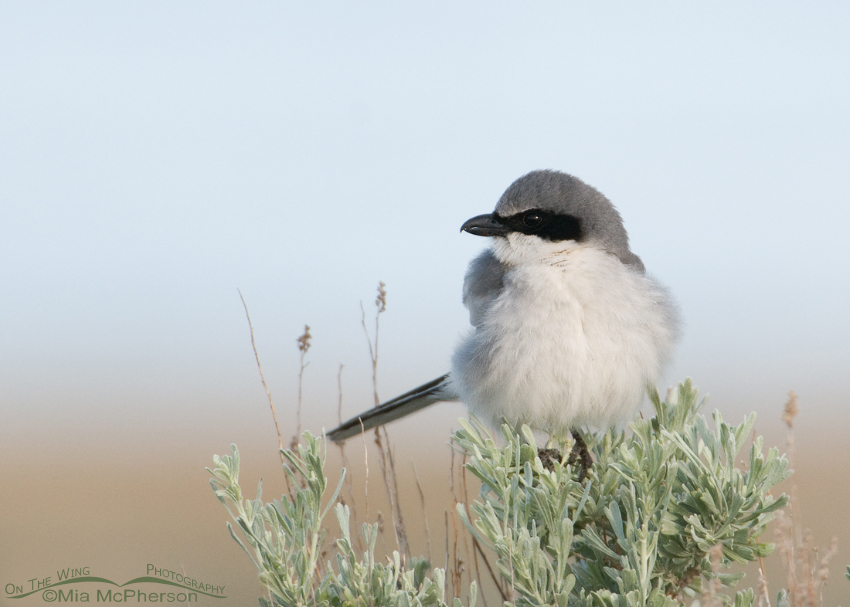 Loggerhead Shrike perched on Sagebrush – Nikon D300, f6.3, 1/640, +0.7 EV, Nikkor 200-400mm VR with 1.4x TC at 400mm, natural light
Loggerhead Shrike perched on Sagebrush – Nikon D300, f6.3, 1/640, +0.7 EV, Nikkor 200-400mm VR with 1.4x TC at 400mm, natural light
I selected the colors for this blog and my web site using the hues of greens from Sagebrush, a shrub that is found in many areas of my adopted state of Utah. I find the gray greens soothing and I have to admit I find the aroma of Sagebrush very appealing. Besides, Sagebrush makes a great perch for many of my subjects.
 Pronghorn does on a hilltop at sunset – Nikon D300, f6.3, 1/3200, ISO 1000, Nikkor 200-400mm VR with 1.4x TC at 400mm, natural light
Pronghorn does on a hilltop at sunset – Nikon D300, f6.3, 1/3200, ISO 1000, Nikkor 200-400mm VR with 1.4x TC at 400mm, natural light
Even though birds are my primary passion for photographic subjects I can’t resist taking images of other subjects like the Pronghorn does above. If there aren’t birds around I will take images of flowers, scenery, mammals, insects and more.
 The Wedge in the San Rafael Swell, Utah – Nikon D200, handheld, f9, 1/2000, ISO 400, -0.3 EV, Nikkor 18-200mm VR at 18mm, natural light
The Wedge in the San Rafael Swell, Utah – Nikon D200, handheld, f9, 1/2000, ISO 400, -0.3 EV, Nikkor 18-200mm VR at 18mm, natural light
I see spectacular views, sun rises and sunsets because of my photographic journeys, some time the views take my breath away. Looking down into the Little Grand Canyon from The Wedge certainly did.
 Coyote eating Falcon leftovers – Nikon D300, f6.3, 1/640, ISO 800, Nikkor 200-400mm VR with 1.4x TC at 314mm, natural light, not baited or called in
Coyote eating Falcon leftovers – Nikon D300, f6.3, 1/640, ISO 800, Nikkor 200-400mm VR with 1.4x TC at 314mm, natural light, not baited or called in
There are times when paying attention to one species gives clues about another. I’d seen Peregrine Falcons feeding on ducks on the shoreline of the Great Salt Lake and later saw a Coyote feeding on the falcon’s leftovers, now I know why the Coyotes were along the causeway the year before which had puzzled me. I love the piled up sheets of ice in the background of this image.
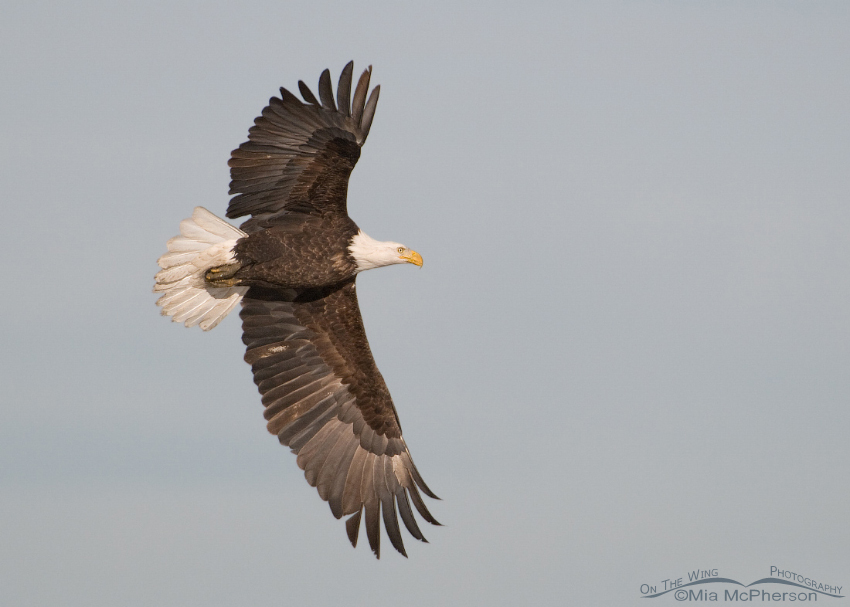 Adult Bald Eagle in flight – Nikon D200, f6.3, 1/2500, ISO 400, +0.7 EV, Nikkor 200-400mm VR with 1.4x TC at 400mm, natural light, not baited
Adult Bald Eagle in flight – Nikon D200, f6.3, 1/2500, ISO 400, +0.7 EV, Nikkor 200-400mm VR with 1.4x TC at 400mm, natural light, not baited
Patience is needed for bird photography, waiting for a bird to fly, waiting for the right banking turn to light the whole bird up and sometimes just waiting for birds to show up.
 Perched adult western Burrowing Owl – Nikon D200, f6.3, 1/400, ISO 200, Nikkor 200-400mm VR with 1.4x TC at 400mm, natural light, not baited
Perched adult western Burrowing Owl – Nikon D200, f6.3, 1/400, ISO 200, Nikkor 200-400mm VR with 1.4x TC at 400mm, natural light, not baited
Because of my bird and nature photography I have met the most interesting people in person and have become friends with many of you through this blog or yours and I appreciate you all. Life is good.
500 posts. Wow.
Mia





Congrats on your 500th post Mia! Of course we all know that we need more from you Your exquisite photography and your insight into what bird photography is all about is truly inspirational and I for one, hope you keep blogging and sharing your thoughts and images for many years to come. I am a true believer that studying the bird’s behavior is the best way to get good photographs and you are obviously in the champion category on that count! Not to mention an excellent crawler
Your exquisite photography and your insight into what bird photography is all about is truly inspirational and I for one, hope you keep blogging and sharing your thoughts and images for many years to come. I am a true believer that studying the bird’s behavior is the best way to get good photographs and you are obviously in the champion category on that count! Not to mention an excellent crawler 
Thank you Larry, I only hope that I am able to keep posting without sounding like a broken record! Your comments on this post are very kind and I appreciate them deeply.
Mia:
500 posts – Wow! I agree.
A great set of photos to celebrate too.
Thanks for the time you spend generating the posts. I usually don’t comment. But I lurk a lot and enjoy the posts even when I don’t take the time to add a comment.
Dave
Thanks Dave, I have had a lot of fun writing the first 500 blog posts!
Congrats on 500 posts Mia! Your photography is exceptional! I admire you for being willing to crawl around in the mud and sand to capture the right shot in the right light! Perhaps one day you and I can meet and hang out together! I would love to pick your photographic brain! As usual, all of these are wonderful shots. It is very hard to pick a favorite!
Kathie, it would be wonderful to hang out together! Thanks so much for your comment on this post, who knew I had so much to say about birds, beasts and photography? I sure didn’t.
Mia, congratulations on your 500th post! I thoroughly enjoyed viewing the spectacular photographs in this post and reading your thoughts on photography. I am truly inspired by each and every one of your posts. After visiting your outstanding blog, I always long to get outside and enjoy nature. Thank you for sharing the background stories of many of your photographs. I have learned a lot about photographing wildlife from the information you have so generously offered. Mia, you are a truly gifted photographer! Your passion for wildlife/nature shines through!
Julie, thanks so much for your comment on my 500th post. I have had such fun sharing my images, the stories behind them and giving photo tips when I can. I’m so glad you enjoy my blog.
Congrats on your 500th post! Your work is incredible and your passion shines in each and every photo!
Tammy, I think we have the greatest subjects. Thanks so much for commenting.
A very happy congratulations to you, Mia on your 500th post! You have inspired me to learn more about photography and take better photos. I enjoy your photos very much and can’t wait for your 1000th post!
Thank you Charlotte, I have a feeling you are going to go far with birding and bird photography, keep up the great work!
Congrats Mia! I love this variety you just put up!
Thank you Maria!
Five hundred fantastic blog posts. I always look forward to seeing a new post from you, Mia. Your photos are always stunning and I enjoy your commentary (and often learn something new).
Thanks Scott, your comments on my posts and images are much appreciated!
Congratulations Mia on your 500 th post! It’s always a delight to see your wonderful photos!
Thank you for commenting Dawn, I think I have fantastic subjects!
As everyone else has stated …. Congratulations, Mia~! It’s not just the number that’s the accomplishment. It’s the incredible quality of your images and posts. I was hooked from the first one I saw. Oh, and speaking of hooked … shorebirds were my “gateway drug,” too! I was laughing at your description of appearances because I think I don’t even notice anymore. I walk into shops covered with dirt and pollen, and forget no one else is wearing the same uniform. Anyway, that’s a digression from the most important facet of this post which is: beautiful work and my heartfelt joy about this milestone.
Thank you Ingrid! I love that shorebirds were your “gateway drug” too! They are so fascinating and photographing them is very addictive. I can only imagine what other people think when we show up someplace covered in mud, sand or wet clothing but like you I don’t think about it much anymore. Thank you for your thoughful comments and your support, I appreciate them and you.
Great post Mia! Nice to learn even more about the person behind the camera! I really enjoy your blog and am looking forward to the next 500 posts and beyond!
Thanks Matthew! I’m looking forward to writing the next 500 posts!
Congratulations Mia, I absolutely love viewing your posts every day, thanks again for sharing:)
Susan, it is my pleasure to share my posts & images. Thank you for your comments!
Mia, congrats on the 500 posts! I love your photography and am so glad that I found your blog. Thank you for sharing your images and stories with us. I look forward to many more!
Thank you Julie, I’m glad we met through our blogs too, I enjoy viewing yours daily.
This is a wonderful post. Love the narrative that goes along with the photos. I’ve been working so much that I haven’t been able to get out much. Your post reminded me how important it is to do that. Looking forward to the next 500 posts!!
Linda, I hope you get some breaks in your work schedule to just go out and soak in nature, you deserve it! Thanks so much for your comments & support.
One of the reasons I enjoy your images is because of your approach to photography. From the technical to the behavior aspects and thinking about the ‘light’. I have enjoyed your post and images very much and look forward to the next 500 posts.
Best Regards,
Jim
Jim, thank you very much, I’m so glad we met on NPN!
Thanks Mia, It is always enjoyable seeing your shots.
Thank you so much Earl!
Congratulations, Mia! Thanks for sharing your experience and your expertise. Beautiful images!! I couldn’t get down to crawl in sand and mud because I would have trouble getting up again, but otherwise walking slowly, standing still frequently, wearing unobtrusive clothing etc I do all that.
Hilke, thank you for your comments and for visiting my blog. Sand crawling isn’t for everyone and some day I won’t be able to get back up either!
My mind is staggered by the time investment and dedication of 500 blog posts — well written and with fantastic photos. That’s commitment! Congratulations, thanks, and keep ’em coming!
Thanks Katie, sharing my images and the stories behind them has become a real joy for me.
Happy 500th! Here’s to another 5000!!! Mia, I’ll never get tired of saying it…you are one of the most talented bird photographers ever. It’s an honor to be one of your admirers and even a greater honor that you share your talents as part of the BirdingIsFun.com team.
Robert, it is a pleasure to be part of the BirdingIsFun.com team and to read the posts there every morning. You are so very kind, I always appreciate your comments!
Congratulations on 500 posts – a great milestone!! I have been following you for quite a while now, and I am always in awe at your AMAZING photos. I don’t usually say anything, because I would be repeating myself all the time!!
Thanks so much Holly, when I first started my blog 500 posts seemed almost unreachable, I didn’t know I had that much to say!
What a neat variety of photos to highlight your 500th post, Mia! Congratulations. Love the shrike photo – all the soft colors and the fluffiness of the bird.
Thanks Tami, I tried to select a nice potpourri of images for this post, I love that Shrike image too because of the fluffy bird and the pastel colors.
Congratulations! I am thrilled to have found your blog and look forward to the next 500 posts and beyond! Your posts are a welcome part of each day for me, and make me feel closer to my recently fledged sons, one who lives in St. Petersburg, FL and the other in Salt Lake City!
Fern, I’m thrilled you found my blog too. I’m glad my blog makes you feel closer to your recently fledged sons, I love that phrase by the way, it made me smile.
They are just beautiful.
Thank you Bob, you are very kind.
Mia, all beautiful photos, as always! I always enjoy reading your blog! Congrats on your 500th!
Thank you so much Karen!
Congratulations on your 500th blog post. As someone who for some time has made a point of reading every one and looking at the photographs you make, I appreciate not only the consistency of your post, but the consistent high quality of pictures. They are jaw-droppingly spectacular. All the time it is pushing me to learn something and helping me to see ways to improve my own craft to even get close to the images you share. It is great to see the passion you have for bird photography and the amazing craftsmanship and artistic ability you display.
Thank you Colin, who knew I had so much to say about birds, wildlife, photography and more? I’ve enjoyed writing every single post and found that my passion for nature photography has opened many doors and windows.
Thank you again.
Fantastic photos Mia!! (As always). Congratulations on your 500th post!! We’ve enjoyed them tremendously. The wise comments too… Thanks again!!
Thank you very much Nicole, nature inspires me.
Congratulations on this milepost!
These images…each one…every one on your blog…are just breathtaking.
i am so glad i saw that juvenile bald eagle, “Binged” (rather than Googled) and discovered your wonderful work!
May you enjoy many, many more outings with your camera. Thank you so much for sharing your work with us!
I’m glad you binged me too Zepyhr, thank you for your comments and for sharing your work too.
Happy 500th Mia. I love this post as it really shows the whole array of photography that you take pleasure in. Such beautiful images that you create with your camera. You are gifted. So glad I found you. Carol
Carol, I am very glad you found me too since now I get to see your beautiful flower and scenery images from Kentucky! Thank you so much for your comments.
Ah, such stunning images. It’s very fun to read about your progress too, and your techniques (normally one has to pay a lot of money to hear from experts
Congratulations on 500 Mia. I don’t know that I’ve read/seen everyone of them, but I’m always glad when I get too, and I’m looking forward to 500 more.
Thank you Laurence, I hope I won’t get boring in the next 500 posts!
Mia, Congratulations! 500 is a real milestone!! Thank you for sharing your amazing images and your bird knowledge. I’ve learned so much from reading your blog. Looking forward to the next 500 posts!
Rachel, thanks for your kind comment, I have loved sharing my images and thoughts.
Wow, Mia! Congratulations on the huge milestone and a fabulous post! I loved reading it and the images are spectacular as always! Here’s to the next 500!!! I love the coyote shot, btw!
Thank you Beverly, I love that Coyote shot too. They are such beautiful creatures
Congratulations on your 500th blog! Awesome images and great info, love it.
Thank you Kim!
Mia, I look forward to your newest blog post in my in-box each morning … I love your photos so much, you have a great talent and you have inspired me to get outside and observe the birds around me here in northeast Philadelphia.
Thank you so much Linda, getting outside is great, isn’t it?